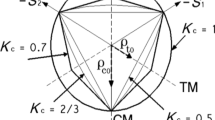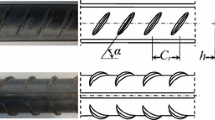Abstract
To establish bonding stress—slip constitutive model between bars and grout concrete, 13 test specimens were employed to study the bonding behavior and the force transfer of bars adhered to grout concrete. The bonding stress development of bars adhered to grout concrete was analyzed. The local bonding stress—slip curve was obtained. Based on the test results, a new bonding stress—slip constitutive model between bars and grout concrete was proposed. The results show that the maximum bonding stress is not influenced by the bar bond length, but it is strengthened when the splitting strength of grout concrete is increased. The model matches the experimental results well, and the regressing coefficient equals 1.7.
Similar content being viewed by others
References
DING Da-jun. Innovation of walls and sustainability of development [M]. Bei**g: China Machine Press, 2005. (in Chinese)
MOON L F, YI T Y, LEON T R, KAHN L F. Testing of a full-scale unreinforced masonry building following seismic strengthening [J]. Journal of Structural Engineering, 2007, 133(9): 1215–1226.
National standard of the People’s Republic of China. Code for design of masonry structure (GB50003 — 2001) [S]. Bei**g: Chinese Construction Industry Press, 2002: 66–87.
VOON K C, INGHAM J M. Design expression for the in-plane shear strength of reinforced concrete masonry [J]. Journal of Structural Engineering, 2007, 133(5): 706–713.
JAMES S, JEFF W, MICHAEL I. Failure mechanisms of polymer-reinforced concrete masonry walls subjected to blast [J]. Journal of Structural Engineering, 2005, 131(8): 1194–1205.
ZHANG X D, SINGH S, BULL D K. Out-of plane performance of reinforced masonry walls with openings [J]. Journal of Structural Engineering, 2001, 127(1): 51–57.
MESBAH A, MOREL J C, WALKER P. Development of a direct tensile test for compacted earth blocks reinforced with natural fibers [J]. Journal of Materials in Civil Engineering, 2004, 16(1): 95–98.
GAVIN D W, MERVYN J K JASON M I. Shake table testing of post-tensioned concrete masonry walls with openings [J]. Journal of Structural Engineering, 2007, 133(11): 1551–1559.
LIU Ming, HUANG Cheng-kui, SUN Hui-feng. Tests and research on the bond behavior of reinforcement and grout concrete [J]. Journal of Shenyang Jianzhu University: Natural Science, 2004, 20(4): 257–260. (in Chinese)
LIU Ming, HUANG Cheng-kui, SUN Hui-feng, CHENG Yun. Study of reliability and behavior of reinforced bond in grout block masonry [J]. Journal of Dalian University of Technology, 2005, 45(6): 837–841. (in Chinese)
YE Mei-xin, HUANG Qiong, WU Qin-qin. Analysis of steel-concrete composite structure with overlap slab of **ngguang bridge [J]. Journal of Central South University of Technology, 2007, 14(1): 120–124.
GUO Zhang-gen, SUN Wei-min, CAO Shuang-yan. Experimental study on bond-slip behavior between FRP and concrete [J]. China Civil Engineering Journal, 2007, 40(3): 1–5. (in Chinese)
YAO J, TENG J G, CHEN J F. Experimental study on FRP-to concrete bonded joints [J]. Composites—part B: Engineering, 2005, 36(2): 99–113.
LU X Z, TENG J G, YE L P. Bond-slip models for FRP sheets/plates externally bonded to concrete [J]. Engineering Structures, 2005, 27(6): 938–950.
DING Fa-xing, YU Zhi-wu. Behavior of concrete and concrete-filled circular steel tubular stub columns at constant high temperatures [J]. Journal of Central South University of Technology, 2007, 14(6): 726–732.
Author information
Authors and Affiliations
Corresponding author
Additional information
Foundation item: Project(2006BAJ03A01-05) supported by National Science and Technology Pillar Program during the 11th Five-Year Plan Period of China; Project (JG200705) supported by Key Laboratory of Structural Engineering of Shenyang Jianzhu University, China
Rights and permissions
About this article
Cite this article
Zheng, Y., Liu, M., Zhou, Jh. et al. Bonding stress—slip constitutive behavior between bars and grout concrete. J. Cent. South Univ. Technol. 16, 841–844 (2009). https://doi.org/10.1007/s11771-009-0139-7
Received:
Accepted:
Published:
Issue Date:
DOI: https://doi.org/10.1007/s11771-009-0139-7




